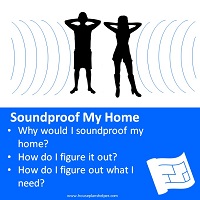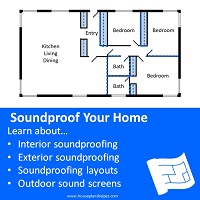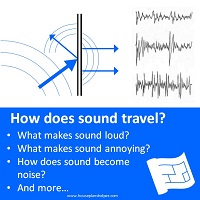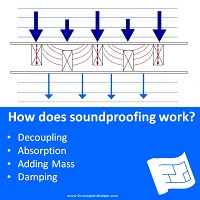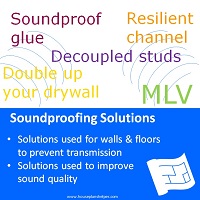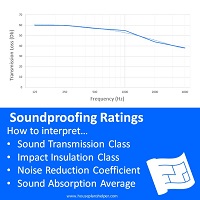- Home
- Soundproofing
- How Does Sound Travel
How Does Sound Travel?
So, how does sound travel?
It helps to understand a bit about how sound travels, how it’s measured and generally how it works before you go ahead and learn more about noise control.
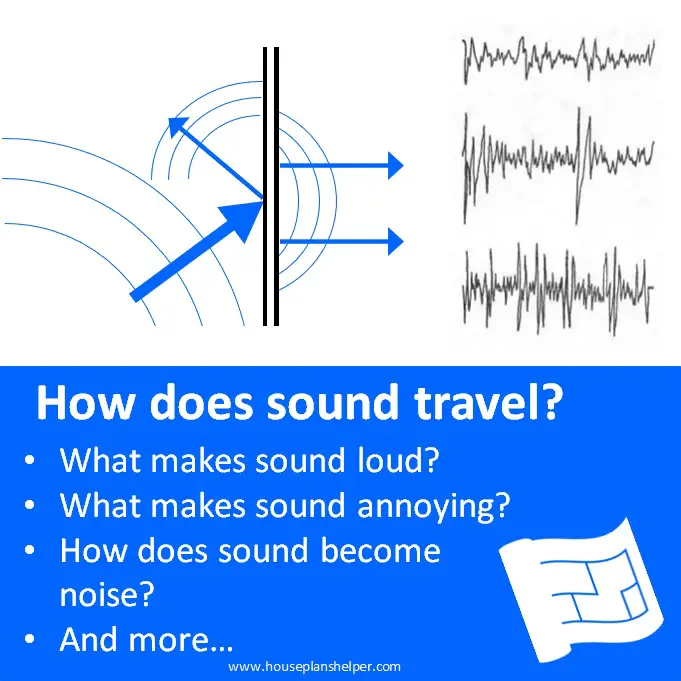
Basic Characteristics of Sound
Sound is a form of energy. It travels as a compression wave and reaches our ears in the form of minute fluctuations in air pressure. Sound waves come in all shapes and sizes with different characteristics that determine how a sound wave sounds to us.
These characteristics are:
- Frequency (pitch – high or low)
- Wavelength (speed)
- Amplitude (volume - loud or quiet)
For the purposes of sound in homes, we’re concerned only with pitch (frequency) and volume (amplitude). It's these two characteristics that can make sound become noise and annoying.
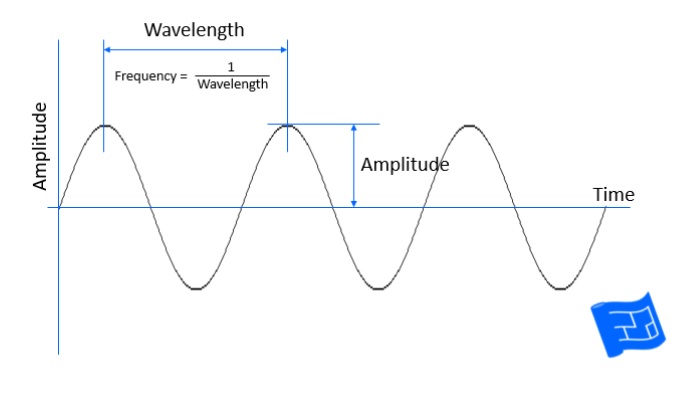 Sound travels as a wave
Sound travels as a wavePitch
Pitch (or frequency) is the number of complete cycles per second, measured in Hertz (Hz). A dental drill would have a high pitch with a short wavelength and a bus would have a low pitch with a long wavelength.
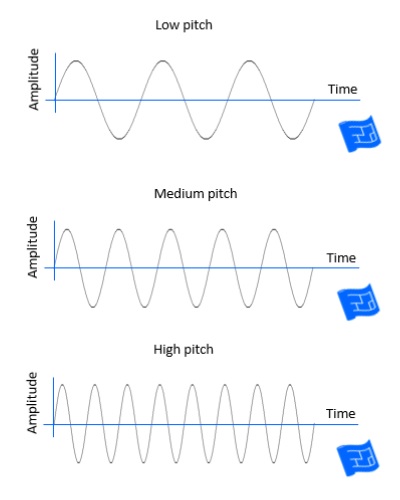
How does sound travel for different household sounds? Here’s some images of different sound signatures of household noises. You’ll notice that they’re not at all neat and in fact are a mix of different sounds which fluctuate in frequency and wavelength over the duration of the sound.
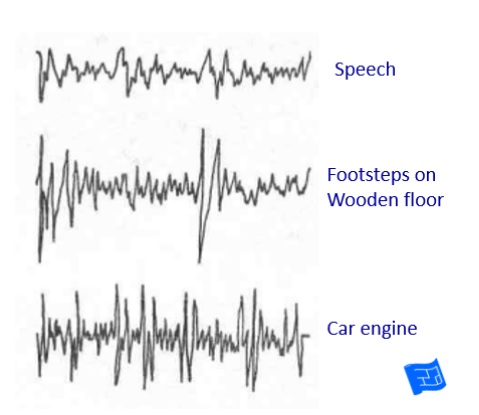
Humans hear sounds between 20Hz and 20,000kHz.
Here’s the typical frequency spectrum of various household noises.
| Source | Typical frequency |
|---|---|
| Male voice | 85 – 100 Hz |
| Female voice | 165 – 255 Hz |
| Footsteps on ahard surface | 40 – 150 Hz |
| Traffic noise | 20 – 4000 Hz |
If we think about sounds from music or a TV here’s the frequency spectrum.
| Range | Frequency |
|---|---|
| Sub-bass | 16 - 60Hz |
| Bass | 60 - 250Hz |
| Lowermidrange | 250 - 500Hz |
| Midrange | 500 - 2kHz |
| Higher midrange | 2 - 4kHz |
| Presence | 4 - 6khz |
| Brilliance | 6 - 20kHz |
Volume
The amplitude of a sound wave is measured in meters, but we’re more interested in how we perceive volume. Volume is related to the energy of the sound wave, and energy is measured in Decibels (Db).
The Decibel scale is non-linear.
The energy of a sound wave doubles about every 3dB or so and yet what we perceive as volume is slightly different. We perceive a doubling of the volume about every 10dB so a sound at 60dB would sound twice as loud as a sound at 50dB.
Here’s some Db levels of some common sounds you might hear inside and outside your home.
| Noise | Decibel (dB)level |
|---|---|
| Lawn mower,jet flyover at 1000ft | 100 |
| Jet take-offat approx. 1 mile, motorcycle at 25ft | 90 |
| Yelling atclose range, freight train at 50ft, garbage disposal, food blender. | 80 |
| Shouting, Vacuumcleaner, Listening to music, Car driving past at 65mph at 25ft, freeway at 50ft, toilet flushing. | 70 |
| Conversationat a dinner party, background music | 60 |
| Conversationat home | 50 |
| Library,Suggested background noise level for sound comfort | 40 |
| Quiet ruralarea | 30 |
| Whisper | 20 |
| Breathing | 10 |
How Sound Travels
After that very brief physics lesson, you may be asking how does sound travel in my home?
Sound can travel in three ways:
- Through the air – Airborne transmission
- Through solid materials – Structural transmission – through walls, doors, windows and floors.
- Through leaks or weak spots in the wall or floor – flanking transmission
Sound travels through the air outside and inside our homes, then it will hit a surface (wall / floor / door / window). What happens then? This is an important question because it helps us to understand how soundproofing works.
How does sound travel when it meets a surface?
When sound meets a surface a few different things can happen depending on the nature of the surface (wall / floor / door / window). The sound waves can behave in a few different ways. It’s always a combination of these behaviors that’s at work.
Reflection
Sound waves are reflected if they hit a hard surface (eg drywall). When sound waves bounce around a room, the space feels very alive, and if there’s too much reflection it starts to become an unpleasant cacophony.
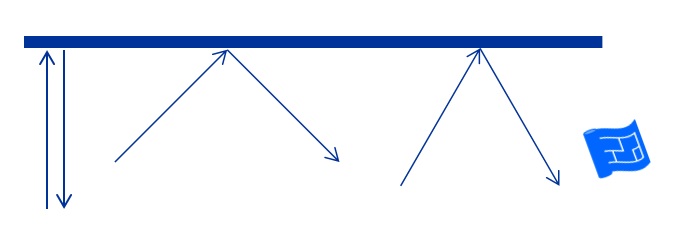
Dissipation
If sound meets an irregular surface, the sound is reflected in all different directions and is dissipated. Dissipation breaks up sound waves, making them less intense and so improves the quality of sound in a room.
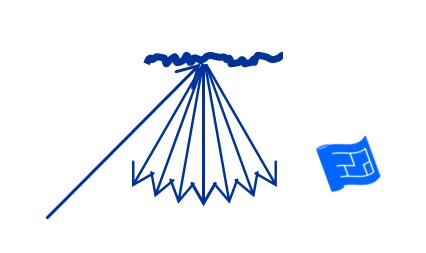
Absorption
If a sound meets a soft surface, such as a curtain, the sound is absorbed. The sound energy is turned into a tiny bit of heat energy. It takes a lot of sound to create much heat, so the heat is negligible.
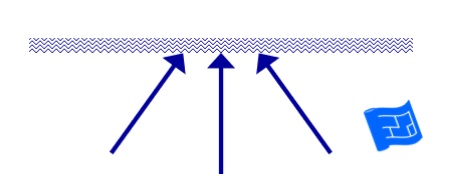
Transmission
When sound hits a solid surface, some of the sound will be transmitted through the material. For example, transmitted through the studs to the wall next door, or through the floor joists between floors.
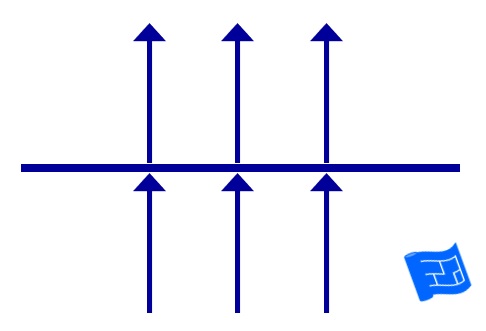
Flanking
Escape through alternative paths (eg outlets and switches) or around the edges of walls where the wall attaches to the floor or ceiling or to a door or window frame. This is called flanking. Flanking paths aren’t usually out and out visible holes, they’re places in the wall or floor that are less soundproof than the rest of the wall or floor.
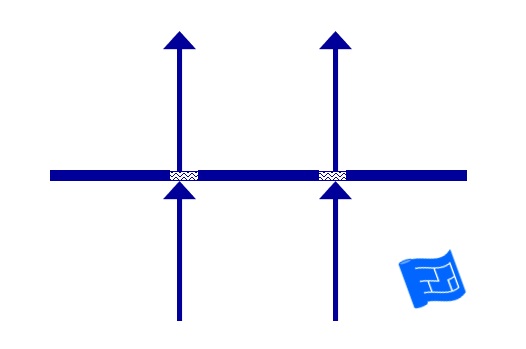
Remember that it’s a combination of the above behaviors that make up how sound behaves in our homes. Sound is never 100% absorbed, 100% reflected, 100% transmitted etc.
A few other facts on 'how does sound travel?'
- Sound can't travel in a vacuum. The less dense the air, the harder it is for sound to travel.
- If two sound waves cross over each other, they interfere with one another. This can lead to the sound being cancelled out, amplified, jumbled up or any mess of noise in between.
These different behaviors form the basis of how soundproofing works.

